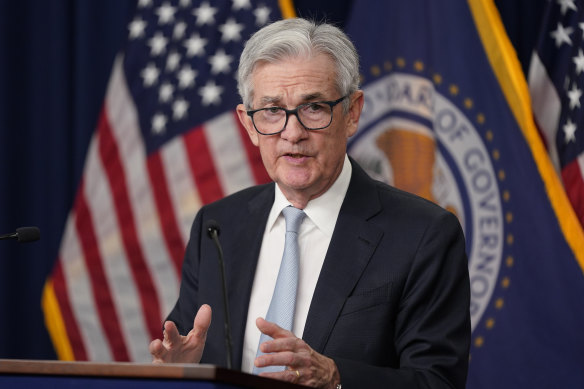Key points
- The Australian sharemarket has climbed by more than 12 per cent since the start of October.
- It has also reacted positively to America’s central bank indicating it will slow the pace of interest rate rises.
- Some experts warn there are still rate rises are to come as inflation is not yet under control.
The Australian sharemarket rally that started in October shows no signs of petering out, leaving investors questioning whether this is a Santa rally that has come early or whether markets are getting ahead of themselves.
The spark for the most recent surge on Wall Street was last week’s comments by US Federal Reserve Board chair Jerome Powell signalling America’s central bank is likely to slow the pace of interest rate rises.
Federal Reserve chair Jerome Powell said the central bank may not have to increase interest rates by as much as inflation moderatesCredit:AP
Our market reacted positively to Powell’s comments and to the rise on Wall Street, as well as to figures released by Australian Bureau of Statistics last week showing inflation was lower than expected.
It came in at 6.9 per cent for the year to October 31. That was down from 7.3 per cent for the year to September 30, but still a long way from the Reserve Bank of Australia’s (RBA) target band of 2 to 3 per cent.
Australian share prices fell by more than 14 per cent from the start of this year to the end of September, but our market has climbed by more than 12 per cent since then.
Russel Chesler, the head of investments and capital markets at exchange-traded funds provider VanEck, has doubts about whether the rally on our market will be sustained.
Inflation is lower, but it is far from vanquished, he says. “It is too early to read too much into [slightly lower inflation],” Chesler says.
He expects the RBA to increase the cash rate further next year, and to peak at 3.85 per cent by mid-2023 from 3.1 per cent now.
Morningstar head of equities research Peter Warnes says while the US Federal Reserve’s Powell did say smaller rate rises may be made by the central bank, Powell also said the increases were not over and that the fight against inflation will extend well into 2023.
“We have likely already had our Santa rally … and you may not see much [more] happening between now and the end of December,” Warnes says.
“Bear markets do not end when central banks are still hiking [rates] and central banks still have plenty of hikes in them.
“I think there will be another leg down before we can say that the bear market is over. I don’t think that will happen until the first half of 2023.”
He is also expecting the cash rate to peak at 3.85 per cent by mid-2023.
However, not all analysts are pessimistic about the market’s end-of-year prospects. Fairmont Equities founder Michael Gables is more optimistic about an extended rally.
“The [Australian] market may well go lower, but it is more likely that we have seen the lows,” Gable says.
He says the market will likely continue to climb because we are through the worst in terms of inflation and could be getting close to the peak in the cash rate.
Gable says the lift in the cash rate by the RBA on Tuesday could even mark the end of rate rises, as inflation continues to moderate.
- Advice given in this article is general in nature and is not intended to influence readers’ decisions about investing or financial products. They should always seek their own professional advice that takes into account their own personal circumstances before making any financial decisions.
Most Viewed in Money
From our partners
Source: Read Full Article


